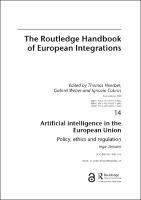Chapter 14 Artificial intelligence in the European Union
Proposal review
Policy, ethics and regulation
Abstract
In the context of recent advances in Artificial Intelligence (AI) and launch of AI policy documents and ethics guidelines around the world, since 2017, the European Union (EU) is developing its approach to AI. This chapter examines the key EU AI policy documents and the way the EU is positioning its AI policy vis-à-vis other global players. It draws on ‘Europe as a power’ debate and in particular on the concepts of Normative Power Europe and Market Power Europe to examine if in its approach to AI the EU prioritizes its norms or rather its market power. In the EU policy documents the elements of both normative and market power are closely intertwined. The EU attempts to project itself globally as a Normative Power Europe promoting its value-based and human-centric approach based and ethics guidelines for Trustworthy AI. These are closely connected with the EU’s ambitions to be a Market Power with appropriate regulation and investments which could also support implementation of its values and norms.
Keywords
CAP; Common Market; EDA; Erasmus; European integration; European Armament; CERN; European media; Eurozone; ITER; European tourism; Artificial Intelligence; European Union; policy; ethics; regulationDOI
10.4324/9780429262081-19ISBN
9780367203078, 9781032182421, 9780429262081Publisher
Taylor & FrancisPublisher website
https://taylorandfrancis.com/Publication date and place
In the conGrantor
Imprint
RoutledgeClassification
Politics and government


 Download
Download Web Shop
Web Shop